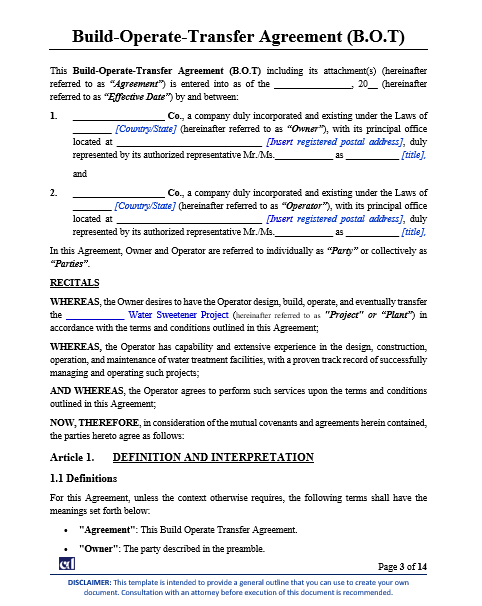Estimated reading time: 3 minutes
Characteristics of BOT Agreements
A Build-Operate-Transfer Agreement (BOT) is a strategic partnership between a public entity and a private company in the energy sector. In this arrangement, the private company finances, constructs, operates, and ultimately transfers ownership of a project back to the public entity.
This model is prevalent in mid- to large-scale infrastructure projects, such as fossil-fuel and renewable power plants, transportation systems, and water treatment facilities. Here, the private sector provides the investment and expertise to deliver and manage the project over a specified period.

- Concession Agreement: The public entity grants a concession to the private company, allowing it to finance, build, and operate the project for a set period, typically spanning two to three decades.
- Profit-Driven Motivation: The private company aims to recover its investment and earn a profit during the project period before transferring the ownership back to the public entity.
- Large-Scale Projects: BOT contracts are typically used for large-scale, greenfield infrastructure projects that would otherwise be financed, built, and operated solely by the government.
- Variations: There are several variations of the BOT model, including Build-Own-Operate-Transfer (BOOT), Build-Lease-Transfer (BLT), and Design-Build-Operate-Transfer (DBOT).
Risks and Challenges
Financial Risks
One of the primary risks associated with BOT contracts is the potential for financial losses if the project does not yield sufficient returns for the private entity. Companies must conduct thorough financial analyses to mitigate these risks.
Unforeseen Challenges
BOT contracts require meticulous planning and execution to ensure success. Unforeseen challenges, such as regulatory changes or environmental issues, can impact project timelines and costs.
Comparing BOT and BOO Agreements
Build-Operate-Transfer (BOT) and Build-Own-Operate (BOO) agreements represent two common models of public-private partnerships. Both structures drive infrastructure development; however, they differ significantly in ownership, risk distribution, and long-term responsibilities.
In a BOT agreement, the private company finances, constructs, and operates the project for a defined period. After that, the company transfers ownership back to the public authority. Consequently, BOT agreements suit large-scale projects such as highways, airports, and public transportation systems. Furthermore, they enable governments to access private capital while ensuring eventual public ownership.
In contrast, a BOO agreement allows the private company to finance, build, and operate the project while retaining full ownership indefinitely. As a result, the company generates long-term revenue by operating facilities such as power plants and utility services. Additionally, BOO agreements appeal to investors who prefer stable, ongoing returns without mandatory transfer requirements.
Therefore, while BOT agreements emphasise temporary private management followed by public ownership, BOO agreements highlight permanent private control. Moreover, these differences reveal distinct approaches to risk allocation, operational authority, and strategic objectives. Ultimately, selecting the appropriate model requires evaluating financial capacity, policy priorities, and long-term development goals.
Note: Build-Operate-Transfer Agreement (B.O.T) and Build-Own-Operate Agreement (B.O.O) models share similarities with B.O.O.T. Agreements but differ in ownership and transfer structures. These alternatives offer governments and private investors additional flexibility in structuring infrastructure partnerships.
Visit the respective pages:
- Public–Private Partnership Project Agreement (PPP)
- Build-Own-Operate Agreement (B.O.O)
- Build-Own-Operate-Transfer Agreement (B.O.O.T)
- Build-Lease-Operate-Transfer Agreement (BLOT)
- Ownership Transfer Acknowledgement
References:
- International Renewable Energy Agency – PPP Models
- World Bank PPP Knowledge Lab
- UNIDO Guidelines for BOOT Projects
has been added to your cart!
have been added to your cart!



